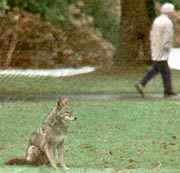
PHOTO: Jon Murray, The Province
Cool coyote looks right at home as
he lounges within sight of humans
near Stanley Park tennis courts.
p. A34.
Coyote invasion sparks fears for kids' safety
Greg Middleton
Staff Reporter
Like brazen bandits, Vanouver's urban coyotes have turned to daring daylight kidnappings and robberies.
Wildlife control officer Dennis Pemble says coyotes have moved into the city, invading city parks, green spaces and even people's back yards. They're getting increasingly bold and aggressive — taking cats and small dogs right off porches and right out from under their owners eyes.
Its so bad that officials are beginning to fear for the safety of small children.
"They have moved right into downtown Vancouver and you can see them in broad daylight and they are doing things we've never seen coyotes do before," Pemble said. "You'll see them lying in the parks under the trees in broad daylight.
"They are running right up to little kids, not because they are intent on attacking them, but because they've learned that is a way to get food."
Pemble figures some children have been feeding them, and as coyotes learn to associate kids with food, they start running up to them. If children get scared and drop their lunches, coyotes quickly learn that taking a run at a child nets them a free lunch.
People have also been warned to keep pets in at night in a growing number of neighbourhoods.
Steve Bailey, who lives near Cambie and 12th, called The Province to say coyotes are becoming a common sight there.
"A couple of tore a lady's cat to pieces right in her back yard," Bailey said. "They snatched it right off her porch."
Pemble said his group will be coming out with a program shortly to educate people about how to deal with coyotes.
Kristine Lampa of the Stanley Park Ecology Society says we'd better learn to live with the urban coyote, because they are not going away — not any of the 2,000 to 3,000 coyotes that live among us in the Lower Mainland.
Wildlife officials, parks department and city officials and animal rescue groups will hold a summit next week to discuss how to deal with the coyote invasion.
They rode the rails
Coyotes are relatively recent immigrants to the West Coast.
"They are grassland animals from the prairies of central North America and down into Central America, not forest dwellers," says Kristine Lampa, who did her master's thesis on the urban coyote. Lampa says coyotes followed the railroad across the mountains and out onto the coast: "A railroad line is like a superhighway to a coyote, complete with roadside restaurants. There is always some spillage. They'll eat the grain and the rats and mice that come down to the tracks to eat the grain."
Coyotes, which have four to six pups a year, first showed up in the upper Fraser Valley in the 1920s.
Lampa said that as more land was opened up to farming, they expanded their range. With suburban development, coyotes found a new favourite: Cats. And now they're learning to live in the city, eating squirrels, small dogs and even garbage.
![[Previous]](../previous_off.gif)
![[Enlarge]](../enlarge_off.gif)
![[Next]](../next_off.gif)